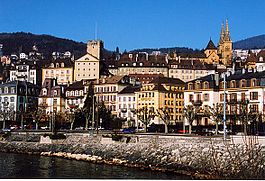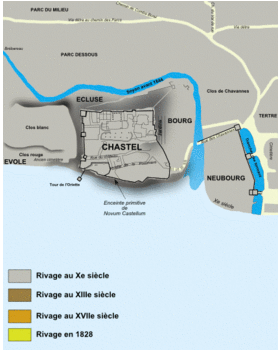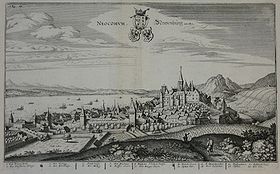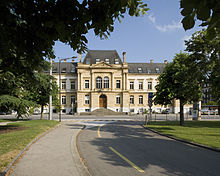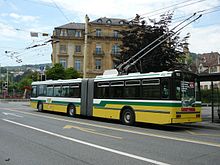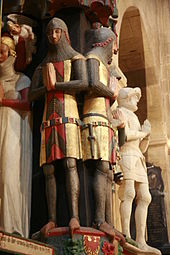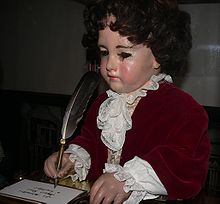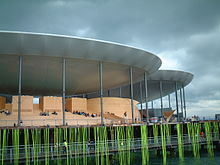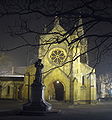- Neuchâtel
-
For other uses, see Neuchâtel (disambiguation).
Neuchâtel Country Switzerland 
Canton Neuchâtel District Neuchâtel 46°59.51′N 6°55.86′E / 46.99183°N 6.931°ECoordinates: 46°59.51′N 6°55.86′E / 46.99183°N 6.931°E Population 32,973 (Dec 2010)[1] - Density 1,827 /km2 (4,731 /sq mi) Area 18.05 km2 (6.97 sq mi) Elevation 430 m (1,411 ft) Postal code 2000 SFOS number 6458 Mayor Antoine Grandjean Surrounded by Auvernier, Boudry, Chabrey (VD), Colombier, Cressier, Cudrefin (VD), Delley-Portalban (FR), Enges, Fenin-Vilars-Saules, Hauterive, Peseux, Saint-Blase, Savagnier, Valangin Twin towns Aarau (Switzerland), Besançon (France), Sansepolcro (Italy) Website www.neuchatelville.ch
Profile (French), SFSO statisticsView map of Neuchâtel Neuchâtel (Old French: neu(f) "new" + chatel "castle" (French: château))[2] is the capital of the Swiss canton of Neuchâtel on Lake Neuchâtel.
The city has as of December 2007[update] approximately 32,600 inhabitants (80,000 in the agglomeration),[3] by and large French-speaking, although the city is sometimes referred to historically by the German name
 Neuenburg (help·info), which has the same meaning, since it originally belonged to the Holy Roman Empire and later Prussia ruled the area until 1848.
Neuenburg (help·info), which has the same meaning, since it originally belonged to the Holy Roman Empire and later Prussia ruled the area until 1848.Neuchâtel is a pilot of the Council of Europe and the European Commission Intercultural cities programme.
Contents
Geography
Neuchâtel has an area, as of 2009[update], of 18.1 square kilometers (7.0 sq mi). Of this area, 1.84 km2 (0.71 sq mi) or 10.2% is used for agricultural purposes, while 9.74 km2 (3.76 sq mi) or 53.8% is forested. Of the rest of the land, 6.42 km2 (2.48 sq mi) or 35.5% is settled (buildings or roads), 0.03 km2 (7.4 acres) or 0.2% is either rivers or lakes and 0.02 km2 (4.9 acres) or 0.1% is unproductive land.[4]
Of the built up area, industrial buildings made up 2.2% of the total area while housing and buildings made up 18.0% and transportation infrastructure made up 10.1%. while parks, green belts and sports fields made up 4.3%. Out of the forested land, 51.8% of the total land area is heavily forested and 2.0% is covered with orchards or small clusters of trees. Of the agricultural land, 1.4% is used for growing crops and 8.0% is pastures. All the water in the municipality is in lakes.[4]
The city is located on the northwestern shore of the Lake of Neuchâtel (lac de Neuchâtel in French and Neuenburgersee in German), a few kilometers east of Peseux and west of Saint-Blaise. Above Neuchâtel, roads and train tracks rise steeply into the folds and ridges of the Jura range – known within the canton as the Montagnes Neuchâteloises. Like the continuation of the mountains on either side, this is wild and hilly country, not exactly mountainous compared with the high Alps further south but still characterized by remote, windswept settlements and deep, rugged valleys. It is also the heartland of the celebrated Swiss watchmaking industry, centered on the once-famous towns of La Chaux-de-Fonds and Le Locle, which both rely heavily on their horological past to draw in visitors. The River Doubs marks the border with France, set down in a gorge and forming along its path an impressive waterfall, the Saut du Doubs, and lake, the Lac des Brenets.
History
See also: History of the canton of NeuchâtelPrehistory
The oldest traces of humans in the municipal area are the remains of a Magdalenian hunting camp, which was dated to 13,000 BC. It was discovered in 1990 during construction of the A5 motorway at Monruz (La Coudre). The site was about 5 m (16 ft) below the main road. Around the fire pits carved flints and bones were found. In addition to the flint and bone artifacts three tiny earrings from lignite were found. The earrings may have served as symbols of fertility and represent the oldest known art in Switzerland. This first camp was used by Cro-Magnons to hunt horse and reindeer in the area. Azilian hunters had a camp at the same site at about 11,000 BC. Since the climate had changed, their prey was now deer and wild boar.
During the 19th century, traces of some stilt houses were found in Le Cret near the red church. However, their location was not well documented and the site was lost. In 1999, during construction of the lower station of the funicular railway, which connects the railway station and university, the settlement was rediscovered. It was later determined to be a Cortaillod culture (middle Neolithic) village. According to dendrochronological studies, some of the piles were from 3571 BC.[5]
A Hallstatt grave (early Iron Age) was found in the forest of Les Cadolles. At Les Favarger a Gallo-Roman and at André Fontaine a small coin depot were discovered. In 1908, an excavation at the mouth of Serrière discovered Gallo-Roman baths from the 2nd and 3rd Centuries AD.
One of the most important Merovingian cemeteries in the canton was discovered at Les Battieux in Serrières. In 1982, 38 graves dating from the 7th century were excavated many of which contained silver inlaid or silver plated belt buckles. Also in Serrières at the church of Saint-Jean, the remains of a 7th century shrine were excavated.[5]
Middle Ages
In 1011, Rudolph III of Burgundy presented a Novum castellum or new castle (Old French neu, now neuf and Old French châtel, now château, in antiquated German: Welschen Nüwenburg or Newenburg am See) on the lake shore to his wife Irmengarde. It was long assumed that this new castle replaced an older one, but nothing about its location or design is known. At the time of this gift Neuchâtel was probably the center of a newly created royal court, which was recently developed to complement the other royal estates which managed western estates of the Kings of Burgundy.[5]
The first counts of Neuchâtel were named shortly afterwards, and in 1214 their domain was officially dubbed a city.
Early modern era
For three centuries, the County of Neuchâtel flourished, and in 1530, the people of Neuchâtel accepted the Reformation, and their city and territory were proclaimed to be indivisible from then on. Future rulers were required to seek investiture from the citizens.
With increasing power and prestige, Neuchâtel was raised to the level of a principality at the beginning of the seventeenth century. On the death in 1707 of Marie d'Orleans-Longueville, duchess de Nemours and Princess of Neuchâtel, the people had to choose her successor from among fifteen claimants. They wanted their new prince first and foremost to be a Protestant, and also to be strong enough to protect their territory but based far enough away to leave them to their own devices. Louis XIV actively promoted the many French pretenders to the title, but the Neuchâtelois people passed them over in favour of King Frederick I of Prussia, who claimed his entitlement in a rather complicated fashion through the Houses of Orange and Nassau. With the requisite stability assured, Neuchâtel entered its golden age, with commerce and industry (including watchmaking and lace) and banking undergoing steady expansion.
Modern Neuchâtel
At the turn of the nineteenth century, the King of Prussia was defeated by Napoleon I and was forced to give up Neuchâtel in order to keep Hanover. Napoleon's fieldmarshal, Berthier, became Prince of Neuchâtel, building roads and restoring infrastructure, but never actually setting foot in his domain. After the fall of Napoleon, Frederick William III of Prussia reasserted his rights by proposing that Neuchâtel be linked with the other Swiss cantons (the better to exert influence over all of them). On September 12, 1814, Neuchâtel became the capital of the 21st canton, but also remained a Prussian principality. It took a bloodless revolution in the decades following for Neuchâtel to shake off its princely past and declare itself, on March 1, 1848, a republic within the Swiss Confederation.
Demographics
Neuchâtel has a population (as of December 2010[update]) of 32,973.[1] As of 2008[update], 32.1% of the population are resident foreign nationals.[6] Over the last 10 years (2000–2010) the population has changed at a rate of 3.9%. It has changed at a rate of 2.4% due to migration and at a rate of 1% due to births and deaths.[7]
Most of the population (as of 2000[update]) speaks French (25,881 or 78.6%) as their first language, German is the second most common (1,845 or 5.6%) and Italian is the third (1,421 or 4.3%). There are 6 people who speak Romansh.[8]
As of 2008[update], the population was 47.7% male and 52.3% female. The population was made up of 10,371 Swiss men (31.5% of the population) and 5,344 (16.2%) non-Swiss men. There were 12,366 Swiss women (37.5%) and 4,892 (14.8%) non-Swiss women.[1] Of the population in the municipality, 8,558 or about 26.0% were born in Neuchâtel and lived there in 2000. There were 5,134 or 15.6% who were born in the same canton, while 7,744 or 23.5% were born somewhere else in Switzerland, and 10,349 or 31.4% were born outside of Switzerland.[8]
As of 2000[update], children and teenagers (0–19 years old) make up 19.3% of the population, while adults (20–64 years old) make up 63.1% and seniors (over 64 years old) make up 17.6%.[7]
As of 2000[update], there were 14,143 people who were single and never married in the municipality. There were 14,137 married individuals, 2,186 widows or widowers and 2,448 individuals who are divorced.[8]
As of 2000[update], there were 15,937 private households in the municipality, and an average of 2. persons per household.[7] There were 7,348 households that consist of only one person and 547 households with five or more people. In 2000[update], a total of 15,447 apartments (89.9% of the total) were permanently occupied, while 1,429 apartments (8.3%) were seasonally occupied and 311 apartments (1.8%) were empty.[9] As of 2009[update], the construction rate of new housing units was 2.5 new units per 1000 residents.[7]
As of 2003[update] the average price to rent an average apartment in Neuchâtel was 921.35 Swiss francs (CHF) per month (US$740, £410, €590 approx. exchange rate from 2003). The average rate for a one room apartment was 451.40 CHF (US$360, £200, €290), a two room apartment was about 675.66 CHF (US$540, £300, €430), a three room apartment was about 825.15 CHF (US$660, £370, €530) and a six or more room apartment cost an average of 1647.88 CHF (US$1320, £740, €1050). The average apartment price in Neuchâtel was 82.6% of the national average of 1116 CHF.[10] The vacancy rate for the municipality, in 2010[update], was 0.53%.[7]
Historic Population
The historical population is given in the following chart:[5]

Historic Population Data [5] Year Total Population French Speaking German Speaking Protestant Catholic Other Jewish Islamic No religion given Swiss Non-Swiss 1850 7,901 7,098 789 7,068 833 1870 12,934 11,012 2,327 11,306 2,284 1888 16,565 11,511 4,651 13,973 2,387 143 94 14,447 2,118 1900 21,195 15,566 4,596 17,548 3,500 232 80 18,108 3,087 1910 24,171 17,543 5,161 19,750 3,944 476 111 20,625 3,546 1930 22,668 17,027 4,612 18,615 3,638 306 63 20,640 2,028 1950 27,998 21,897 4,784 21,439 5,891 308 58 26,307 1,691 1970 38,784 26,200 5,117 21,882 15,262 2,352 59 76 791 30,012 8,772 1990 33,579 24,579 2,467 13,198 13,305 4,462 55 481 5,634 24,250 9,329 2000 32,914 25,881 1,845 10,296 10,809 3,767 58 1,723 7,549 22,801 10,113 Economy
Renowned for its watch industry, Neuchâtel has been able to position itself as the heart of micro-technology and high-tech industry. During the last 20 years, the region of Neuchâtel has attracted many leading companies in the high-tech sectors such as medical technology, micro technology, biotechnology, machines & equipments, IT and clean technologies.
Le Locle and its geographical twin town La Chaux-de-Fonds, up in the Jura Mountains, have now been recognised as an UNESCO World Heritage Site, for their horological and cultural past.
Neuchâtel is home to research centres and well-known organizations such as Swiss Centre of electronics and micro techniques (CSEM),[11] Micro technology Institute of the university IMT,[12] Engineer’s School of Arc Jurassien EIAJ, Neode (scientific and technological park),[13]
As of 2010[update], Neuchâtel had an unemployment rate of 7.5%. As of 2008[update], there were 46 people employed in the primary economic sector and about 14 businesses involved in this sector. 5,658 people were employed in the secondary sector and there were 261 businesses in this sector. 20,472 people were employed in the tertiary sector, with 1,955 businesses in this sector.[7] There were 16,353 residents of the municipality who were employed in some capacity, of which females made up 45.4% of the workforce.
In 2008[update] the total number of full-time equivalent jobs was 21,624. The number of jobs in the primary sector was 38, of which 20 were in agriculture and 18 were in forestry or lumber production. The number of jobs in the secondary sector was 5,433 of which 4,234 or (77.9%) were in manufacturing, 9 or (0.2%) were in mining and 1,022 (18.8%) were in construction. The number of jobs in the tertiary sector was 16,153. In the tertiary sector; 2,397 or 14.8% were in the sale or repair of motor vehicles, 796 or 4.9% were in the movement and storage of goods, 919 or 5.7% were in a hotel or restaurant, 766 or 4.7% were in the information industry, 1,077 or 6.7% were the insurance or financial industry, 1,897 or 11.7% were technical professionals or scientists, 1,981 or 12.3% were in education and 2,633 or 16.3% were in health care.[14]
In 2000[update], there were 15,535 workers who commuted into the municipality and 6,056 workers who commuted away. The municipality is a net importer of workers, with about 2.6 workers entering the municipality for every one leaving.[15] Of the working population, 33.7% used public transportation to get to work, and 43.4% used a private car.[7]
Education
Neuchâtel is home to the French-speaking university of Neuchâtel. The university has five faculties (schools) and more than a dozen institutes, including arts and human sciences, natural sciences, law, economics and theology. For the 2005–2006 academic year, 3,595 students (1,987 women and 1,608 men) were enrolled. The Faculty of Arts and Human Sciences is the largest school of those that comprise the university of Neuchâtel with 1,500 students.
Neuchâtel is home to 8 libraries. These libraries include; the Bibliothèque de la Faculté des Lettres, the Bibliothèque de l'Institut d'ethnologie et du Musée d'ethnographie, the Bibliothèque de la Faculté des Sciences, the Bibliothèque de droit, the Bibliothèque des sciences économiques, the Bibliothèque de la Faculté de théologie, the Service de coordination des bibliothèques and the Haute école Arc - Santé. There was a combined total (as of 2008[update]) of 736,773 books or other media in the libraries, and in the same year a total of 58,427 items were loaned out.[16]
In Neuchâtel about 11,076 or (33.7%) of the population have completed non-mandatory upper secondary education, and 5,948 or (18.1%) have completed additional higher education (either university or a Fachhochschule). Of the 5,948 who completed tertiary schooling, 43.6% were Swiss men, 28.4% were Swiss women, 16.4% were non-Swiss men and 11.6% were non-Swiss women.[8]
In the canton of Neuchâtel most municipalities provide two years of non-mandatory kindergarten, followed by five years of mandatory primary education. The next four years of mandatory secondary education is provided at thirteen larger secondary schools, which many students travel out of their home municipality to attend.[17] During the 2010-11 school year, there were 27 kindergarten classes with a total of 527 students in Neuchâtel. In the same year, there were 78 primary classes with a total of 1,424 students.[18]
As of 2000[update], there were 3,859 students in Neuchâtel who came from another municipality, while 346 residents attended schools outside the municipality.[15]
Transportation
- Neuchâtel has local public transport provided by Les Transports Publics du Littoral Neuchâtelois (TN), which operates an extensive Trolleybus network, a Funicular, and an Interurban light rail line to Boudry. The total length of the TN network is 81.2 km (50.5 mi). It serves 78,400 people (more than half using it on a daily basis) and in 2007 transported 17,670,000 travelers.[19]
- The city is linked to the TGV (High Speed Train). Direct trains link Neuchâtel to Paris in four hours.
- Neuchâtel's airport is about 6 km (3.7 mi) away from the center of the city and it takes 9 minutes to get into town with the direct tramway. It is a small airport that does not offer commercial flights. Neuchâtel is also linked to four international airports: Bern, Geneva, Basel and Zurich which are respectively 58 km (36 mi), 122 km (76 mi), 131 km (81 mi) and 153 km (95 mi) away by car. Geneva and Zurich airports both have direct trains to Neuchâtel, connecting the cities respectively in 1h 17min and 1h 49min.[20]
- The Société de Navigation sur les Lacs de Neuchâtel et Morat SA is the boat company which serves 17 towns on Lake Neuchâtel, 6 towns on Lake Murten and 7 towns on Lake Bienne from 6:30am to 9pm. Some boats offer free wireless internet connections.[21]
Main sights
Heritage sites of national significance
There are 32 sites in Neuchâtel that are listed as Swiss heritage site of national significance. The entire old city of Neuchâtel is part of the Inventory of Swiss Heritage Sites.[22]
- Archeological sites: Paleolithic settlement at Monruz
- Churches: Abbey of Fontaine-André, Collegiate Church of Neuchâtel et cénotaphe, Notre-Dame Church
- Houses: Maison des Halles, Maison at Rue du Pommier 7, Maison at Rue du Pommier 8 or Rue du Château 19, Maison at Rue du Pommier 9, Villa James de Pury with an annex decorated with frescos by Hans Erni
- Libraries and Museums: Bibliothèque des Pasteurs de Neuchâtel, Galeries de l‘Histoire, Musée d‘art et d‘histoire de Neuchâtel, Musée d‘ethnographie, Muséum d‘histoire naturelle
- Schools: Collège Latin
- Public Buildings and Structures: Neuchâtel Castle and archives, Fountain of Justice, Fountain at place de l‘Hôtel de Ville, Fountain at rue des Moulins, Fountain at rue du Château, Banneret Fountain, Griffon Fountain, Lion Fountain, Neubourg Fountain, City Fortification, Grande Rochette, City Hall, Hôtel Du Peyrou, Cantonal Observatory at Rue de l‘Observatoire 52, Parc de la Petite Rochette, Poste at Place Numa-Droz 2, Prison tower and former prison at Rue Jehanne-de-Hochberg 3
Architecture
Neuchâtel’s Old Town is attractive, with about 140 street fountains, a handful of which date from the sixteenth century. The Place des Halles is overlooked by fine Louis XIV architecture – shuttered façades and the turreted orioles of the sixteenth-century Maison des Halles. A two-minute walk east, on Rue de l’Hôpital, is the grand 1790 Hôtel de Ville (Town Hall), designed by Louis XVI’s chief architect Pierre-Adrien Paris.
The center of the Old Town are located at the top of the hill, accessed by the steeply winding Rue du Château. The Collégiale church, begun in 1185 and consecrated in 1276, is a graceful example of early Gothic. The east end of the church, has three Norman apses. The main entrance, to the west, is crowned by a giant rose window of stained glass. Within the vaulted interior, the transept is lit by a lantern tower. The unique Cenotaph of the Counts of Neuchâtel is located on the north wall of the choir. Begun in 1372, and the only artwork of its kind to survive north of the Alps, the monument comprises fifteen near-life-size painted statues of various knights and ladies from Neuchâtel’s past, framed by fifteenth-century arches and gables. Beside the church is the Castle, begun in the twelfth century and still in use as the offices of the cantonal government. The nearby turreted Prison Tower, which is the remains of a medieval bastion, has panoramic views over the town, along with interesting models of Neuchâtel in different eras.
Museums
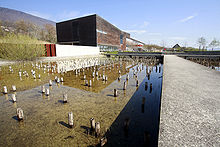 Park and Museum of the Laténium museum
Park and Museum of the Laténium museum
Neuchâtel has several museums, including the Laténium, an archeology museum focusing on the prehistorical times in the region of Neuchâtel and Hauterive, particularly the La Tène culture; the MEN, an ethnography museum; The flagship Musée d’Art et d’Histoire, Esplanade Léopold-Robert, and its star attractions, the astonishing Automates Jaquet-Droz (Jaquet-Droz Mechanical Figurines) are also notable.
The ground floor is devoted to the historical collections, with rooms on the history of Neuchâtel. Upstairs are the rooms devoted to fine art, which have been organized radically differently from most other museums. Instead of displaying works by period, or artist, or genre, the collection is grouped by theme, with the various rooms labelled Nature, Civilization, The Sacred, and so on. In each room you can climb podia – each one hung all round with paintings – in order to get a better view of the works hung high on the four walls.
In a room at the rear of the ground floor the Automates Jaquet-Droz are displayed. The Automates are three mechanical figurines built to the most exacting technical standards by a Neuchâtelois watchmaker in the 1770s and still in perfect working order today. The three – the Draughtsman, the Writer and the Musician – are displayed static behind glass. The Draughtsman is a child sitting at a mahogany desk and holding a piece of paper with his left hand; his right hand, holding a pencil, performs extraordinarily complex motions to produce intricate little pictures of a dog, the god Eros in a chariot pulled by a butterfly, or a noble profile of Louis XV. The Writer, a chubby-cheeked little boy, also sits at a mahogany desk, with a goose quill in his right hand and a tiny pot of ink nearby for dipping. He writes in a florid and chunky style, and staggeringly enough, can even be programmed to produce any text of up to forty characters. While he writes, his eyes follow the words across the page. But perhaps the most charming of the three is the Musician, a gracious young girl with slender and dextrous fingers who plays a small organ – a real instrument, not a disguised musical-box. As her fingers strike the keys to produce the notes and her eyes, head and body move subtly from side to side in time, her chest rises and falls delicately in an imitation of rhythmic breathing. Her melodies were composed in the early 1770s by Henri-Louis Jaquet-Droz.
Pierre Jaquet-Droz (1721–90) was born in La Chaux-de-Fonds into a venerable and wealthy local family. After studying theology at university, he returned to Neuchâtel – by then already a centre for clock and watchmaking – and worked to combine his interest in mathematics with the skills of applied mechanics used by the artisans of the watch industry. By the age of 26, Jaquet-Droz had gained a reputation for technical brilliance, and in 1758 he and his father-in-law, a craftsman named Abram Sandoz, travelled to Madrid to show off the skill of Neuchâtelois clockmakers at the Spanish court (Jaquet-Droz’s so-called “Shepherd’s Clock” is still on display in one of the King of Spain’s palace museums).
Jaquet-Droz was by now wealthy enough to retreat from business life and concentrate on problems of applied mathematics, exemplified in his construction of incredibly complex mechanical figurines – the earliest of computers – designed to do particular tasks. He trained his son, Henri-Louis, and a colleague, Jean-Frédéric Leschot, to work with him; together, they produced the Writer, the Draughtsman and the Musician, and presented all three for the first time to the public in La Chaux-de-Fonds in 1774. Writers of the day reported that people flocked from all over the country to see such extraordinary works of whimsy and technical skill. The same year, the three craftsmen showed their figurines in drawing rooms and royal palaces all across Europe, from London to Russia and Paris to Madrid, receiving high acclaim wherever they went. Perhaps aware of impending revolutionary violence in France and Switzerland, Jaquet-Droz sold the figurines to a collector in Spain in 1778. After the conflicts, in 1812, they reappeared in Paris and began touring again. Some twenty years later, they became the centrepiece of Martin and Bourquin’s “Museum of Illusions”, which toured Central Europe until the turn of the century. In 1906, helped by a grant from the Swiss federal government, Neuchâtel bought the figurines back, and they have been on display in the town’s museum ever since, in virtually the same condition as when they were first made, almost 230 years ago.
International relations
- Neuchâtel is a pilot city of the Council of Europe and the European Commission Intercultural cities programme.[23]
Culture
During the summer of 2002, Neuchâtel was one of five sites which held Expo.02, the sixth Swiss national exhibition, which was subject to financial controversy. The festival of the Fête des Vendanges, representing the wine harvest, is held traditionally in early Fall.\
Politics
In the 2007 federal election the most popular party was the SP which received 30.31% of the vote. The next three most popular parties were the SVP (19.09%), the FDP (12.17%) and the Green Party (11.44%). In the federal election, a total of 9,566 votes were cast, and the voter turnout was 49.6%.[24]
Religion
From the 2000 census[update], 10,809 or 32.8% were Roman Catholic, while 9,443 or 28.7% belonged to the Swiss Reformed Church. Of the rest of the population, there were 374 members of an Orthodox church (or about 1.14% of the population), there were 80 individuals (or about 0.24% of the population) who belonged to the Christian Catholic Church, and there were 1,756 individuals (or about 5.34% of the population) who belonged to another Christian church. There were 58 individuals (or about 0.18% of the population) who were Jewish, and 1,723 (or about 5.23% of the population) who were Islamic. There were 99 individuals who were Buddhist, 100 individuals who were Hindu and 59 individuals who belonged to another church. 7,549 (or about 22.94% of the population) belonged to no church, are agnostic or atheist, and 1,717 individuals (or about 5.22% of the population) did not answer the question.[8]
Sport
Neuchâtel Xamax is a football club based in Neuchâtel. They play in the Swiss Super League, the highest Swiss football league. It was created in 1970 through a merger between FC Cantonal (1906) and FC Xamax (1916). The club plays in red shirts, black shorts and red socks and are currently in the Axpo Super League, the highest Swiss football league. They play their home matches at the Stade de la Maladière.
Notable people
Jean Piaget, Robert Miles, and Marcel Junod were all born in Neuchâtel. Friedrich Dürrenmatt lived in Neuchâtel the last 30 years of his life. Canadian illustrator John Howe, well known for his illustrations of J. R. R. Tolkien's work and his participation in Peter Jackson's The Lord Of The Rings trilogy as chief conceptual designer, also lives in the Swiss city. It was also the site of a secret first meeting between French novelist Honoré de Balzac and the married woman who later became his wife, Eveline Hanska.[25]
Roger Schutz, founder of the Taize Community in France, was born on 12 May 1915 at the village of Provence near Neuchâtel. He was stabbed to death on 16 August 2005 by a mentally deranged woman during a prayer meeting in Taize's Church of Reconciliation.
The psychiatrist and psychoanalyst Silvio Fanti was born in Neuchâtel in 1919. He founded and developed Micropsychoanalysis, a new school of psychoanalysis. Another important psychiatrist, Gottlieb Burckhardt, practiced in Neuchatel.
Francois Bigot, the last Intendant of New France.
It is also the current residence of French tennis sensations Richard Gasquet, Gilles Simon and Florent Serra.
Coat of arms
The blazon of the municipal coat of arms is Or, an Eagle displayed Sable beaked, langued and membered Gules, escutcheon Or, on a pale Gules three Chevrons Argent.[26]
Weather
Climate data for Neuchâtel Month Jan Feb Mar Apr May Jun Jul Aug Sep Oct Nov Dec Year Average high °C (°F) 2.6
(36.7)4.7
(40.5)8.7
(47.7)13.1
(55.6)17.5
(63.5)21
(70)24
(75)23.3
(73.9)19.6
(67.3)13.4
(56.1)7.1
(44.8)3.5
(38.3)13.2 Daily mean °C (°F) 0.5
(32.9)2
(36)4.8
(40.6)8.5
(47.3)12.6
(54.7)16
(61)18.6
(65.5)17.9
(64.2)14.8
(58.6)10
(50)4.6
(40.3)1.4
(34.5)9.3 Average low °C (°F) −1.4
(29.5)−0.4
(31.3)1.7
(35.1)4.8
(40.6)8.7
(47.7)11.9
(53.4)14.1
(57.4)13.7
(56.7)11.2
(52.2)7.4
(45.3)2.7
(36.9)−0.3
(31.5)6.2 Precipitation mm (inches) 73
(2.87)69
(2.72)69
(2.72)63
(2.48)82
(3.23)93
(3.66)77
(3.03)97
(3.82)81
(3.19)67
(2.64)81
(3.19)81
(3.19)932
(36.69)Avg. precipitation days 11.1 10.2 10.8 10.2 12.4 10.9 9.3 10.1 8 8.5 9.8 10.5 121.8 Source: MeteoSchweiz [27] Gallery
See also
- Intercultural cities
- L'Express is published in Neuchâtel.
- Neuchâtel Junior College
References
- ^ a b c Canton of Neuchatel Statistics, République et canton de Neuchâtel - Recensement annuel de la population (German) accessed 13 October 2011
- ^ It was called Neuchâtel outre Joux too to make the difference with another Neuchâtel in Burgundy, now Neuchâtel-Urtière.
- ^ Bundesamt fur Statistik (Federal Department of Statistics) (2008). "Bilanz der ständigen Wohnbevölkerung (Total) nach Bezirken und Gemeinden". http://www.bfs.admin.ch/bfs/portal/de/index/themen/01/02/blank/key/raeumliche_verteilung/kantone__gemeinden.html. Retrieved November 5, 2008.
- ^ a b Swiss Federal Statistical Office-Land Use Statistics 2009 data (German) accessed 25 March 2010
- ^ a b c d e Neuchâtel in German, French and Italian in the online Historical Dictionary of Switzerland.
- ^ Swiss Federal Statistical Office - Superweb database - Gemeinde Statistics 1981-2008 (German) accessed 19 June 2010
- ^ a b c d e f g Swiss Federal Statistical Office accessed 25-October-2011
- ^ a b c d e STAT-TAB Datenwürfel für Thema 40.3 - 2000 (German) accessed 2 February 2011
- ^ Swiss Federal Statistical Office STAT-TAB - Datenwürfel für Thema 09.2 - Gebäude und Wohnungen (German) accessed 28 January 2011
- ^ Swiss Federal Statistical Office-Rental prices 2003 data (German) accessed 26 May 2010
- ^ "Swiss Center for Electronics and Microtechnology". csem.ch. http://www.csem.ch/.
- ^ "IMT homepage". unine.ch. http://www2.unine.ch/imt.
- ^ "Neode Homepage". neode.ch. http://www.neode.ch/.
- ^ Swiss Federal Statistical Office STAT-TAB Betriebszählung: Arbeitsstätten nach Gemeinde und NOGA 2008 (Abschnitte), Sektoren 1-3 (German) accessed 28 January 2011
- ^ a b Swiss Federal Statistical Office - Statweb (German) accessed 24 June 2010
- ^ Swiss Federal Statistical Office, list of libraries (German) accessed 14 May 2010
- ^ EDK/CDIP/IDES (2010). Kantonale Schulstrukturen in der Schweiz und im Fürstentum Liechtenstein / Structures Scolaires Cantonales en Suisse et Dans la Principauté du Liechtenstein (Report). http://edudoc.ch/record/35128/files/Schulsystem_alle.pdf. Retrieved 24 June 2010.
- ^ Statistical Department of the Canton of Neuchâtel Mémento de l'année scolaire 2010/2011 (French) accessed 17 October 2011
- ^ (French) "Statistiques (données 2009)". tnneuchatel.ch. http://www.tnneuchatel.ch/entreprise.asp/2-0-180-5507-6-5-0/.
- ^ "Bienvenue sur l'Aéroport de Neuchâtel (LSGN)". neuchatel-airport.ch. http://www.neuchatel-airport.ch/.
- ^ (French) "Bienvenue à bord". navig.ch. http://www.navig.ch/navigation.php?id=9&page=accueil&lang=fr.
- ^ "Kantonsliste A-Objekte" (in German). KGS Inventar. Federal Office of Civil Protection. 2009. http://www.bevoelkerungsschutz.admin.ch/internet/bs/de/home/themen/kgs/kgs_inventar/a-objekte.html. Retrieved 25 April 2011.
- ^ [author missing] (2011 [last update]). "Intercultural city: Neuchâtel Canton, Switzerland". coe.int. http://www.coe.int/t/dg4/cultureheritage/culture/Cities/neuchatel_en.asp. Retrieved 22 May 2011.
- ^ Swiss Federal Statistical Office, Nationalratswahlen 2007: Stärke der Parteien und Wahlbeteiligung, nach Gemeinden/Bezirk/Canton (German) accessed 28 May 2010
- ^ Maurois, André. Prometheus: The Life of Balzac. New York: Carroll & Graf, 1965. ISBN 0-8818-4023-8. Page 228.
- ^ Flags of the World.com accessed 25-October-2011
- ^ "Temperature and Percipitation Average Values-Table, 1961–1990" (in German, French, Italian). Federal Office of Meteorology and Climatology MeteoSwiss. http://www.meteoswiss.admin.ch/web/de/klima/klima_schweiz/tabellen.html. Retrieved 8 May 2009.
External links
- (English) City of Neuchâtel official website
- (French) Transports Publics du Littoral Neuchâtelois
- (French) Neuchâtel Directory
- Museums
- Neuchâtel Tourism Office
- Neuchâtel Junior College
- Hotel Beaulac on Lake Neuchâtel
Cornaux | Cressier | Enges | Hauterive | La Tène | Le Landeron | Lignières | Neuchâtel | Saint-Blaise
Canton of Neuchâtel | Districts of Canton Neuchâtel | Municipalities of the canton of Neuchâtel

Capitals of Swiss cantons Neuchâtel, Neuchâtel
Stans, Nidwalden
Sarnen, Obwalden
Schaffhausen, SchaffhausenCategories:- Municipalities of the canton of Neuchâtel
- Municipalities of Switzerland
- Archaeological sites in Switzerland
- Cities in Switzerland
- Cantonal capitals of Switzerland
- Canton of Neuchâtel
- Cultural property of national significance in the canton of Neuchâtel
Wikimedia Foundation. 2010.

